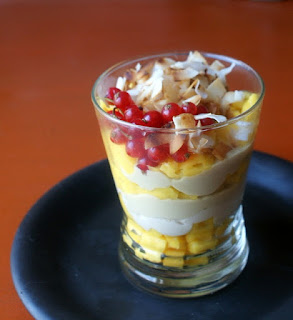Breakfast, for some people, is the most boring meal of the day. Many find it dull because they have been reaching for the same ingredients to make the same boring dishes for the most of their lives. Typically, in America breakfast consists of a toast with jam, eggs, yogurt, orange juice or a store bought cereal served with cold milk. Pancakes and waffles with fruit on holidays. Very predictable, not exciting and not so healthy at all.
But
when you discover that there are other alternatives – both healthy, exciting
and easy to make – you may change your mind and decide that the first meal of
the day is not so boring, after all.
As I mentioned in one of my previous posts, breakfast should be healthy and well-balanced to restore glucose level after its drop at night and provide energy for the body and mind. It shouldn’t be huge or too heavy because in the morning, our digestive system is not ready to break down and absorb nutrients from a heavy meal. It reaches its highest potency later, at a lunchtime, so lunch should be the largest meal of the day.
I
find breakfast bowls a great alternative to those other traditional foods
typically prepared for breakfast. They consist of cooked grains, possibly
gluten free, mixed with nuts, seeds, spices and dried or fresh fruits. Such
combinations make them nourishing and easy to digest. Whole grains that provide
complex carbohydrates are important component of a healthy breakfast because
they take longer to break down into blood glucose and offer indigestible fibers
that aid in gut health and prevent constipation. Adding a small amount of clarified butter (ghee) to the cooked grains will increases the absorption of nutrients. Ghee
is also anti-aging.
When
you find yourself feeling bored thinking of reaching for a box with cereal again to mix it with
cold milk, think again and change your breakfast routine. A breakfast bowl
prepared with cooked grain of your choice combined with your favorite nuts,
seeds and fruits will transform your perception of the first meal of the day.
You don’t have to eat a bowl of grains every day, but try it once to see how
many different options there is. Creativity kills boredom, that’s one sure
thing.
Some nutritional facts about plums:
- Great source of vitamin B1, B2, B3, B6, vitamin C, E and potassium
- Supply dietary fiber and are low in calories
- Help increase absorption of iron into the body
- Destroy breast cancer cells
- Are full of antioxidants that improve brain memory and slow down the progress of Alzheimer's disease
 Serves 2
Serves 2 Ingredients:
- 11/2 cup cooked millet
- 8-10 fresh plums, lightly stewed
- 2 tbsp clarified butter or olive oil
- 3-4 tsp agave nectar
- 1/2 tsp ground turmeric
- 1/8 cup raw pumpkin seeds
- 1/8 cup walnuts, lightly toasted
- 1/8 cup hemp seeds (optional)
- pinch of salt
Preparation:
Divide the millet and other ingredients between two bowls - about 3/4 cup of millet per bowl. Add olive oil or clarified butter and agave nectar, salt and turmeric to the millet and stir well. Slice the plums (I used Italian plums for this bowl) into halves, remove pits and place the plums in a small saucepan with about 3 tbsp of water. Stew the plums over low-medium heat for about 2 minutes. Set aside, spoon out the juice and add it to the millet. Stir it well. Adding the plum juice will enrich the flavor of the millet and make the mixture lightly moist. Arrange the plums on top of the millet, sprinkle the hemp and pumpkin seeds in the middle and toasted walnuts around the plums. I sliced the plums thinner - into quarters - but this is totally optional.
.
Tip: Millet can be cooked
a day before and warmed up before breakfast with about 1/8 cup of water. Bring
it to a simmer, turn off the heat after about 30 seconds. Cover and let it sit
for about 5 minutes. Fluff it up with a fork. It should be eaten warm.
Warning: Millet,
regardless of its great nutritional value, should be eaten in moderation,
preferably once a week or less. It contains goitrogens, substances that suppress thyroid
activity and when eaten in large quantities may lead to thyroid imbalances. Millet is not
recommended for people with hyphothyroidism.


